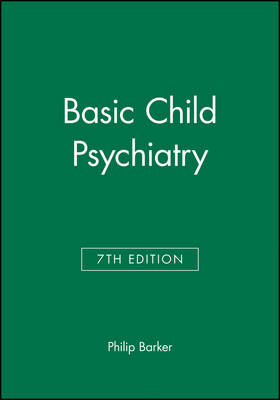
Basic Child Psychiatry
Wiley-Blackwell (Verlag)
978-0-632-05675-0 (ISBN)
The seventh edition of Basic Child Psychiatry has been completely revised and updated to take account of advances in this fascinating and important subject.
The opening chapters set the scene with developmental considerations, epidemiology and assessment. Coverage includes causal factors and reflects the progress made in the understanding of the genetics of child psychiatric disorders. The main body of the book guides the reader through the major disorders. The final chapters address child abuse and neglect, treatment approaches and prevention. References are provided to enable readers to locate more information on subjects they wish to pursue further.
The book refers to the widely used systems of classifying psychiatric disorders – the World Health Organisation’s ICD-10 Classification of Mental and Behavioural Disorders and the American Psychiatric Association’s Diagnostic and Statistical Manual of Mental Disorders (DSM-IV-TR) - and provides a succinct orientation chapter on these systems.
Philip Barker, MB, BS, FRCPsych, FRCP(Ed), FRCP(C), is Professor Emeritus of Psychiatry, University of Calgary, Canada. He has held senior appointments in child psychiatry in the United Kingdom and Canada. Professor Barker has made a wide contribution to the literature in the field, with a clarity of style that has made child psychiatry accessible to thousands of readers.
1. Developmental Considerations. Learning about normal child development.
Developmental stages.
The development of self-esteem.
Development in adulthood.
Family development.
Further reading.
2. Causes of Child Psychiatric Disorders.
Genetic factors.
Intra-uterine disease and injury.
Brain disease and injury.
Temperamental factors.
Environmental factors.
Multifactorial causation.
3. Classification of Child Psychiatric Disorders.
The American Psychiatric Association’s scheme.
The World Health Organization’s diagnostic scheme.
Summary.
4. Epidemiology.
A classic study.
Subsequent studies.
Summary.
5. Assessing Children and Their Families.
Family interviews.
Taking the history.
The developmental history.
Examining the child.
The physical examination.
Other sources of information.
Psychological tests.
Other tests and investigations.
The formulation.
6. Conduct and Oppositional Disorders.
Definition and classification.
Prevalence.
Causes.
Description.
Specific symptoms.
Juvenile delinquency.
Associated disorders.
Treatment.
Outcome.
7. Hyperkinetic and Attention-Deficit Disorders.
Definitions and prevalence.
Causes.
Description.
Assessment and treatment.
Outcome.
8. Anxiety Disorders.
Definition and classification.
Prevalence.
Causes.
Clinical features.
A word of warning.
School refusal.
Other neurotic disorders: Neurasthenia.
Treatment.
Outcome.
9. Mixed Disorders of Conduct and Emotions.
Clinical features.
Treatment.
Outcome.
10. Major Affective Disorders, Suicide and Dysthymia.
Classification.
Depression in children and adolescents.
Prevalence.
Causes.
Depression.
Suicide, suicidal behaviour and deliberate self-harm.
Mania and manic states.
Bipolar disorders.
Dysthymia.
Cyclothymia.
Treatment.
Outcome.
11. Pervasive Developmental Disorders.
Prevalence.
Causes.
Autism.
Atypical autism.
Asperger’s disorder.
Rett’s syndrome or disorder.
Childhood disintegrative disorder.
Other pervasive developmental disorders.
Non-verbal learning difficulties.
Treatment.
Other treatment possibilities.
Outcome.
12. Specific Disorders of Development.
Speech and language problems and communication disorders.
Reading and spelling problems.
Problems with mathematics.
Developmental disorders of motor function.
Mixed specific developmental disorders.
13. Schizophrenia and Other Psychoses of Childhood.
Childhood onset schizophrenia.
Outcome.
Schizoaffective disorders.
Acute and transient psychotic disorders and brief psychotic disorder.
Toxic confusional and delirious states.
14. Enuresis and Encopresis.
Enuresis.
Encopresis.
15. Reactions to Stress.
Adjustment disorders.
Post-traumatic stress disorder.
Acute stress reaction and acute stress disorder.
16. Other Psychiatric Syndromes.
Personality disorders.
Psychosexual problems.
Other psychosexual problems.
Tics and Tourette’s Syndrome.
Stuttering.
Elective mutism/selective mutism.
The Kleine-Levin syndrome.
Episodic dyscontrol syndrome/intermittent explosive disorder.
Factitious illness by proxy.
17. Mind-Body Relationships.
The influence of the body on the mind.
The effects of the mind on the body.
Psychosomatic considerations in child psychiatry.
Asthma.
Eating disorders.
18. Infant Psychiatry.
Assessment.
Disorders of infants and young children.
Regulatory disorders.
Sleep disorders.
Feeding difficulties and failure to thrive.
Depression.
Aggressive behaviour disorders.
Treatment in infant psychiatry.
19. Special Problems of Adolescence.
Prevalence of psychiatric disorders in adolescence.
Unresolved childhood disorders.
Disorders related to puberty and adolescence.
Adult-type disorders arising in adolescence.
Suicidal behaviour in adolescence.
Drug and alcohol abuse.
Treatment approaches.
Outcome.
20. Psychiatric Disorders in Mentally Retarded Children.
The prevalence of psychiatric disorders in the mentally retarded.
Clinical associations and causes of mental retardation.
Types of mental retardation.
Clinical management.
Treatment approaches.
Some other points about management.
Outcome.
21. Child Abuse and Neglect.
Background.
Incidence.
Causes.
Other associations of abuse and neglect.
Clinical considerations.
The role of psychiatrists.
Some points about managing abusive and neglectful families.
Outcome.
22. Treatment Approaches.
Treatment goals.
Individual psychotherapy.
Therapy and counseling with parents.
Family therapy.
Group therapy.
Behaviour therapy.
Pharmacotherapy.
Hypnosis and Hypnotherapy.
Day treatment.
Inpatient and residential treatment.
Educational measures.
Speech and language therapy.
Removal from parental care.
Child psychiatric consultation and liaison.
23. Prevention.
Variations in vulnerability.
Primary prevention methods.
Secondary prevention.
Tertiary prevention.
Conclusion
| Erscheint lt. Verlag | 24.5.2004 |
|---|---|
| Verlagsort | Hoboken |
| Sprache | englisch |
| Maße | 170 x 241 mm |
| Gewicht | 454 g |
| Themenwelt | Medizin / Pharmazie ► Medizinische Fachgebiete ► Pädiatrie |
| Medizin / Pharmazie ► Medizinische Fachgebiete ► Psychiatrie / Psychotherapie | |
| ISBN-10 | 0-632-05675-4 / 0632056754 |
| ISBN-13 | 978-0-632-05675-0 / 9780632056750 |
| Zustand | Neuware |
| Haben Sie eine Frage zum Produkt? |
aus dem Bereich


